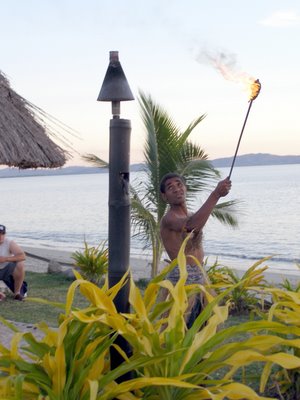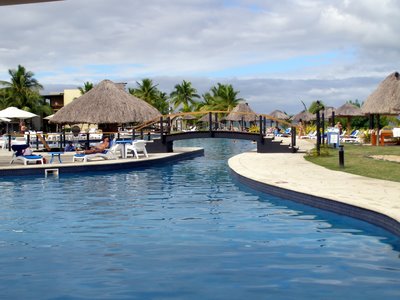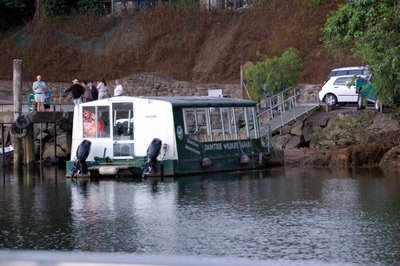This week we took a three day trip about 100 km north of Cairns to the Daintree Rainforest and, after waiting for semi decent weather, a snorkeling trip to the outer Great Barrier Reef.
The Daintree Rainforest is a UNESCO World Heritage Site and is a very isolated area with the oldest rain forest on the planet, having survived all the ice ages. It has incredible trees, among them all kinds of palms, ferns, and a mind boggling jumble of vines and hanging air roots that twist themselves around other trees forming fantastic thick knots and rope like features. There are also huge mangrove swamps with many varieties that go right down to white coral beaches. Little of the area has electric power or telephones. The drive to Mossman was through flowering fields of sugar cane ready for harvest. In Mossman, which lies at the edge of the Daintree National Park we took a hike through the Mossman Gorge which has some wonderful old forests with huge (!!!!) fig trees, palms and vines everywhere. The hike took us along some very pretty streams and rapids. The fig trees have huge above ground, buttress root systems that support the trees during strong winds. The ground was completely covered with roots in all directions. After our hike we drove to Daintree Village (population 90) and took a river cruise on the Daintree River where we saw a number of birds, crocodiles, and snakes in the trees, including a huge python. There were cow pastures along parts of the river and our guide pointed out the skeletons of cows that the crocs had eaten. Apparently no people have been attacked for 30 years, the last one being a woman on the dock where we got the cruise (needless to say we stayed way back from the edge of the water!). We stayed for the next two nights a small wonderful accommodation inside the rain forest about 5 km down a dirt road. One early morning Dahlia took a walk and saw a wallaby (small kangaroo) staring at her in a field nearby. Sadly he ran when he saw the camera go up. The next day we took a guided tour thorough another section of the rain forest on property owned by the guide’s family. It was a wonderful hike with only four other people and Di, our guide, was able to give a good insight into some of the trees and plants and the history of the area. She pointed out one of the first EVER flowering plant species and one of the first fern species to inhabit the world.
The next day we left Daintree Village, took a small ferry across the Daintree River and drove north to Cape Tribulation, a place where Captain Cook ran aground on the reef and had to spend several months repairing his ship the Endeavor. It is also the end of paved roads north and 4WD vehicles are required for the next 250 km to Cape York, the most northerly tip of Australia. The drive took us through the Daintree National Park, which has a number or pristine rain forest areas. We were told of the fearsome Cassowary, the world’s third largest bird (after the Ostrich and Emu). The birds are huge and very aggressive with giant claws that they use for kick boxing and can rip a person open. There are warning signs all around to tell you how to react if you see one (don’t run and hide behind a tree). They are an endangered species and there are only 1,500 Southern Cassowary left. Although we did not see one in the wild (and we looked very carefully!) we talked to many tourists who did see them. We later saw a couple at a wildlife sanctuary. We stopped along the way and took hikes on several boardwalks through, otherwise, impenetrable mangrove swamps and the interface with the rain forest and beach. It was a wonderful experience.
That afternoon we drove to Port Douglas, and spent the night on the way back to Cairns. Port Douglas is a quaint upscale resort town with great restaurants and shopping. The next morning we went to the Rainforest Habitat Wildlife Sanctuary in Port Douglas and had “Breakfast with the Birds”. This was essentially like a giant aviary where all the birds that posed no danger to people as well as kangaroos and wallabies are allowed to fly and roam around at will with a relatively low canopy of trees and a translucent roof. There was a huge assortment of tropical birds. While having a lovely buffet breakfast we were entertained by a variety of beautiful native birds flying over, walking around and landing on the tables (bird flu?). We finally got to see a real Cassowary (on the other side of a fence), and more koalas, crocs and kangaroos. It was a great place to visit!
After returning to Cairns with only two days left we decided to head for the reef despite far less then ideal conditions. We couldn’t bring ourselves to leave the area without seeing the outer part of this world’s greatest coral reef. There was a little bit of drizzle and pretty strong winds, but we armed our selves with sea sickness pills (Kwells), and off we went on the Silverswift a large catamaran dive boat with about 50 other people. We arrived at the outer reef, about 35 miles from Cairns, in about 90 minutes on the rough sea. Once at the reef the water was calmer and the boat stopped at three different reef locations, each for about an hour or so. About half the people were snorkelers and the rest scuba divers, we were among the snorkelers. The reef was spectacular, despite the overcast skys, with sandy patches and large coral heads with unbelievable variety of coral and gazillions of brilliantly colored fish in all sizes. There were giant clams, hard brain coral, soft coral, and coral that looked like fans. We saw a couple of small sharks, large sea slugs and some people (not us) saw a giant sea turtles. It was a fantastic experience and we captured some of it on a digital underwater camera that we rented. There was a great buffet lunch on the boat and at the end of the day we were able to wash off with fresh water from a hose and use changing rooms downstairs to change into warm clothes. When we got home we were exhausted.
Our last day here is windy and rainy so we are using to pack, update the blog and prepare for the next leg of trip to Fiji tomorrow. It is hard to believe we will be back home in little more than a week.


















































